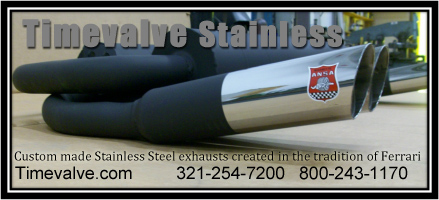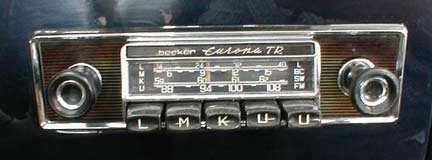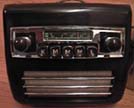 .
.


Though I am an audiophile type I wanted to keep the car as stock a possible. Seeing those 60's era cars with modern stereos was, I felt, somewhat of an abomination. Furthermore, I took a perverse joy in the idea of fat 60's mono tube sound co-existing with the fat sounding Colombo designed 12 cylinder under the hood. One problem, the car didn't have an antenna and I only had a radio to work with. I did some research into faux systems that would play through the radio and maybe use an amp to boost output to the speakers but couldn't come up with an equation of a hidden, and powered, CD player and amp that made sense.
I knew there had to be a small MP3 player solution and finally Apple came up with one, their iPod. You could get a small battery powered radio transmitter that transmits into the FM band of a radio and a cigarette lighter charger along with the iPod itself. So with the smallest iPod holding 60 albums worth of music, this seemed to be the way to go.
I had a shop that does a lot of work with classic cars and car stereos pull the radio so that I could compare a modern 4 x 6 speaker with two modern 3.5" smaller speakers that I had been told would sound better. They didn't really seem to sound better, (or louder) with the radios 7 watts of power so I stuck with the modern 4 x 6 and returned the two 3.5's. However when I tested the iPod through the radio we didn't seem to be able to get any signal. Maybe the FM band of this radio (that came with the car) was not working right. So I packed up the radio, a Blaupunkt, and sent it off to Willie Wilkes (see suppliers page) in Western Pennsylvania. (The installers also found a modern radio antenna buried under the dash so I sent that to Willie also.)
Willie called me about a week later, in his best Walter Brennan-like
voice said, "Yale, I'll tell you what's wrong with your radio's FM band,
the Blaupunkt Stuttgart you have is only an AM radio! "
"So what are those other bands on the push buttons," I said.
"Shortwave and longwave, which they don't have in the U.S.," said Willie,
"I'll fix your knobs, your antenna works well and I'll return the whole
thing to you, cost is $50 for my bench time."
Ok great I thought, I paid $50 to find out I have a useless AM radio.
Time to look for another radio. Since I was going to investigate this subject
I thought I should write it up in case others wanted some more radio information.
Please don't take the below as gospel as I am no expert. I did read a few
articles and talked to a bunch of radio experts but of course some of the
information is contradictory and some of it is just vague. For instance,
Tom mentions his radio is a Franfurt TR but he says it has tubes, well
according to my research if it does have tubes (and we can assume Tom knows
what a tube looks like) it is instead a Frankfort TG which is partially
tube and partially solid-state. The original car radios used the tubes
to tune and for the power supply. As they got more modern, at first only
the power supply lost the tubes and then the radios became all transistorized.
Since the car was a 1964 model I asked Willie what Blaupunkt - that had FM - would go in the car in that year. He said a Frankfurt or a Koln, which are the same radio only the Koln has auto tuning. "I have a Frankfurt in stock it's $380." Well, I really like that auto tuning I thought as I had seen a Mercedes station wagon many years ago with a Becker Mexico with auto tuning. For this era radio the auto tuning actually made the needle on the dial move up and down the dial. A cool feature. Willie didn't have a Koln.
I looked on Ebay and there were Becker Mexico's, and Blaupunkt Frankfurts but no Koln's. The better looking Mexico and Frankfurts from the sixties seemed to be starting at $250 and the "buy it now" option was $350. I remembered I had a UK Mercedes magazine with an article on a German old car radio dealer that I had saved for just this eventuality.
May 2002 Mercedes Enthusiast has an article on Jorg Wagner (ph 011 49
21 4614 21) (new website www.0700carradio.com).
There was a picture of his shop and it's 5000 older German car radios.
I gave him a call and he had the radios of the era that had search tuning
(as it was called), the Becker Mexico ($395), also the Blaupunkt Koln ($380)
and he had the Blaupunkt Frankfurt (for $285).
To be frank, it was a bit more then I expected to pay. I had come across
another German dealer of old car radios on a Google search, Rainer Koenigs,
(011 49 210-244-4441) whose web site (http://www.koenigs-klassik.de/indexe.html)
listed prices in the $180 area.
Rainer speaks English just fairly so it was a slight struggle to get
clear information when it came to details. However on prices he was very
clear. He says he has 20,000 radios! and has a point of view of what radio
should go in what car. For me he says the top of the car radio line in
1964 was a Becker Grand Prix ($400) which is the same radio as the Mexico
but the Grand Prix also had push buttons while the Mexico just had a tuning
bar. "This is what should go in a Ferrari." What about the $180 dollar
price on your site I
asked? "Those are for the one piece radios," he said.
The early sixties was the end of the hybrid partial tube radios, these were two piece units in which the amp was separate. When car radios started being made with solid-state components they worked to keep the tube sound and kept the radios in two pieces. For Becker these were the TG series, Mexico TG, Europa TG, etc. Around 1964 they switched to all transistorized radios that were also in two pieces, for Becker and Blaupunkt this was the TR series. Later in the '60's the radios changed their tube based design and fit in one box. I wanted a two piece radio which I thought might have a fatter sound. By the way, everybody warned me about the full tube radios as being problematic. (They also warned me about ebay radios often being in poor shape.)
I liked that the Mexico just had a bar with no buttons. It bothered me a bit though that a Blaupunkt was what was in my car and here I was thinking about a Becker. It also bothered me that from what I had read the Becker Mexico was named after Mercedes' win in the Carrera Panamerica in Mexico. I thought that it was a bit disloyal to the Ferrari ovure to have a radio that celebrates Mercedes' win over Ferrari (among others). Of course Rainer had Mexico's and Koln's ($360 each for the two piece ones) and I felt I should really choose between these two.
There are only a few pictures on Rainer's site of actual radios so I
did a Google picture search and came up with some photos of Mexico's. One
of which I really loved, a flat chrome face plated radio on a Mercedes
190SL page. .
.
However upon doing some more research I found out that this radio was exclusive to Mercedes 190SL's. Hmm that just didn't feel right to me.
Rainer felt that if I was going to get a Blaupunkt Koln there were special face plates that I should opt for. It seems for Blaupunkt all the face plates are interchangeable (by era of course). So, though it would be correct for the face plate with two black plastic squares that came with my Stuttgart to be used (on any of the appropriate Blaupunkt radios), Rainer felt on a Ferrari what should be used was their more prestigious chrome face plate.
Below are some other faceplates that can be used for Koln.
I had made up my mind as to which radio I should get when on the way to work I stopped at the Strand Bookstore. This is a very large NYC bookstore that sells used and remainder books. They had a large book called the complete Ferrari. One of those relatively useless coffee table car books. I looked through it for some radio guidance. Not too many radios were shown, however on a page with a Lusso there was a very restored interior with a consol radio box containing one of those flat chromed face plated Becker Mexico's. Tom didn't think Lussos ever came with radios so I decided not to use that for my guide and stick with the Koln.
I also found out from Rainer that the Mexico, Koln, and Grand Prix of
the early transistor era came with a DIN plug (mono) to plug in an auxiliary
sound input. He sells an add on old style mono DIN to stereo mini converter
cable so that I could plug the MP3 player straight in. Now when I get it
all I have to do is find out if that 7 watt amp can drive a modern speaker.
More to come, maybe.

American version Koln radio

Becker Europa (tube)

Europa TR

Blaupunkt Stuttgart (in an older style Bakelight case.)
Also in my research I called Ed Ebel at Becker U.S. (http://www.beckerautosound.com/)
(201) 327-3434 / (888) 423-353)They fully
support the old radios and Ed has written many times with information
into a Mercedes list I am on. He is very generous with his knowledge. Becker
will repair any era Becker radio and you can even buy these restored '60's
era radios directly from them at about $600.
Pictures of period radios http://www.mbzponton.org/valueadded/other/radios.htm
Yale Evelev